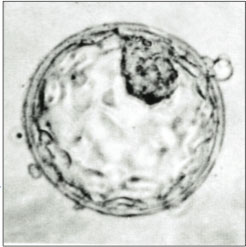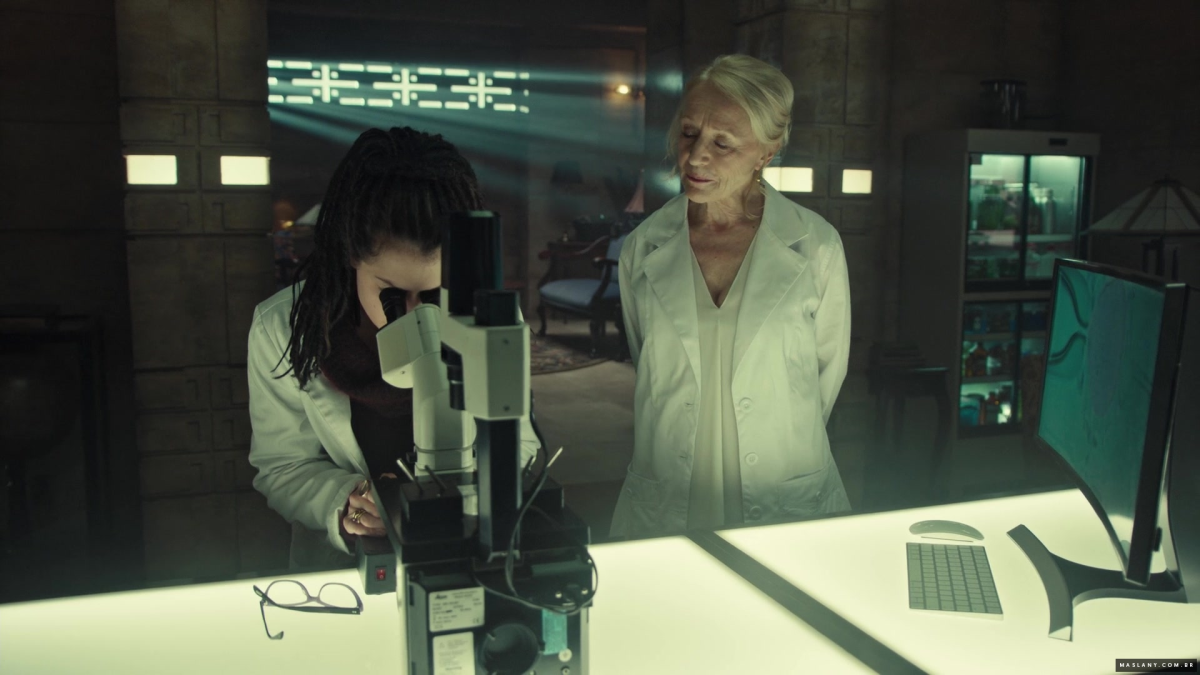Welcome to our Orphan Black science recaps, where Casey, a graduate student in genetics and developmental biology, and Nina, a professional science communicator, examine the science in each episode of OB and talk you through it in (mostly) easy-to-digest terms.
If you haven’t watched the latest episode of Orphan Black, be forewarned: there will be spoilers. There will also be crazy science.
Nina: Some major stuff happened in this episode, including the answer to the question that fans (and Cosima) have been asking since the season three finale: is Delphine Cormier alive? On the science front, Cosima and Susan have been taking the first steps toward a treatment for the clone disease.
Casey: In this week’s episode we saw Cosima working with Susan to develop the Leda/Castor cells necessary for further development of the clone disease cure. Specifically, we witnessed Susan guiding Cosima while she fertilized Sarah’s egg with Ira’s sperm.
The process of fertilizing Sarah’s egg is known as intracytoplasmic sperm injection, or ICSI. This involves injecting a single healthy sperm cell directly into a mature egg cell, as we saw Cosima do under the microscope using an injecting needle. The needle containing the sperm cell was used to rupture the membrane of the egg cell. Once inside the egg, the sperm was then injected into the cell and the needle was removed. The cell membrane then recloses as the sperm chromosomes come together with the egg chromosomes, completely the process of fertilization.
Once fertilization is complete, the cell containing the fused genomes from the sperm and egg is known as a zygote. This cell will divide symmetrically without increasing in size (a process known as cleavage), until about the fifth day after fertilization. At this point, referred to as the morula stage, the cells undergo compaction coupled with cell division to form the blastocyst, which is the stage at which Cosima can harvest the embryonic stem cells.

A human blastocyst. The inner cell mass, the clump of cells in the upper right of the blastocyst, is the source for embryonic stem cells. (image via Wikimedia Commons)
Nina: We also finally gained some important insight to Rachel’s strange visions of swans and strange men. When Rachel first saw a swan at the end of “The Antisocialism of Sex”, it seemed to be a complex hallucination (hallucinations have no external stimulus or input), but over the past few episodes, it becomes clear that these images are being sent to her and, as Rachel says, someone is trying to show her something.
Bionic eyes as complex and effective as Rachel’s just don’t exist yet, but there are technologies that can at least partially restore vision. The most well-known tech is the Argus II implant, which was developed for people with retinitis pigmentosa, a disorder in which the rod receptor cells in the retina of the eye slowly degrade and lose the ability to respond to light. These, along with cones, are the cells that translate light into the signals that are sent to the visual centers of the brain. The tech involves an implant on the retina inside the eye that has a receiver antenna and electrodes, and a sunglasses-like headset equipped with a camera and a transmitter. The camera records an image of what is in front of the person, the image is processed into a signal, and that signal is transmitted to the implant in the eye. The implant’s electrodes then produce electric impulses that stimulate nerve cells in the retina, which send the impulses to the visual cortex of the brain to be interpreted as sight.
The Argus II equipment is much bulkier than Rachel’s practically invisible bionic eye, and the image it produces is not in color and is nowhere near clear vision, but it allows for people who were previously experiencing total blindness to perceive light and simple, high-contrast images (like a large white square on a black background). It also takes some practice for people using Argus II to learn how to interpret the images they they see.
Rachel’s eye, however more advanced, does seem to use some similar tech. We know that her bionic eye contains a camera that records and processes what she sees, and it would also translate the processed image into electric impulses to be interpreted in her visual cortex (the Argus II relies on an intact retina; it’s hard to say how much of Rachel’s pencil-punctured eye was salvageable for this use). Especially if there is a transmitter-receiver situation happening, it wouldn’t be too hard to interfere with the implant such that it could pick up secondary input from a separate source at the same time as Rachel’s eye-cam. Her brain would then process both and integrate them into a single image, complete with the visual artifacts or “glitchy” appearance of a poorly- or remotely-transmitted input.
Casey: It seems that the stage is set for some pretty intense science to take the stage in the finale. Will Cosima make headway toward a cure before it’s too late? (Oh man, I hope so!) Will Rachel’s bionic eye help her help the Leda clones? Will Delphine make an official return to Team Science Mega Force? We can’t wait to see!
Nina: Only one! episode! left!
Casey Griffin is a graduate student in genetics and developmental biology. She dissects mouse hearts, does lots of PCRs, and nerds (and cries and screams) about Orphan Black. You can check out her OB Science Time Tumblr posts here.
Nina Nesseth is a professional science communicator, writer, and serial tea-drinker. She’s happiest when science-ing at people (yes, that’s “science” as a verb). You can find her on Twitter @cestmabiologie.
—Please make note of The Mary Sue’s general comment policy.—
Do you follow The Mary Sue on Twitter, Facebook, Tumblr, Pinterest, & Google +?









Published: Jun 13, 2016 01:17 pm